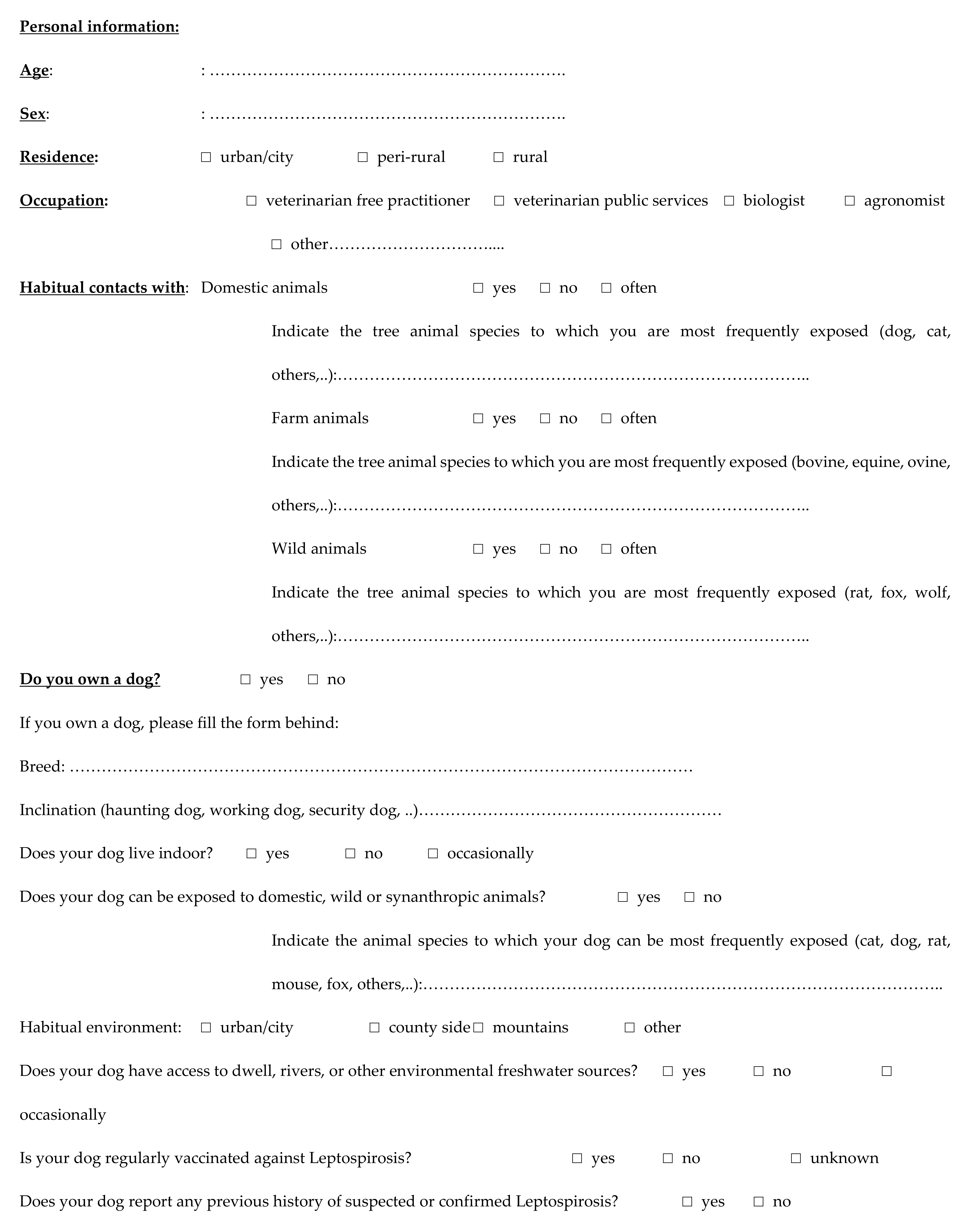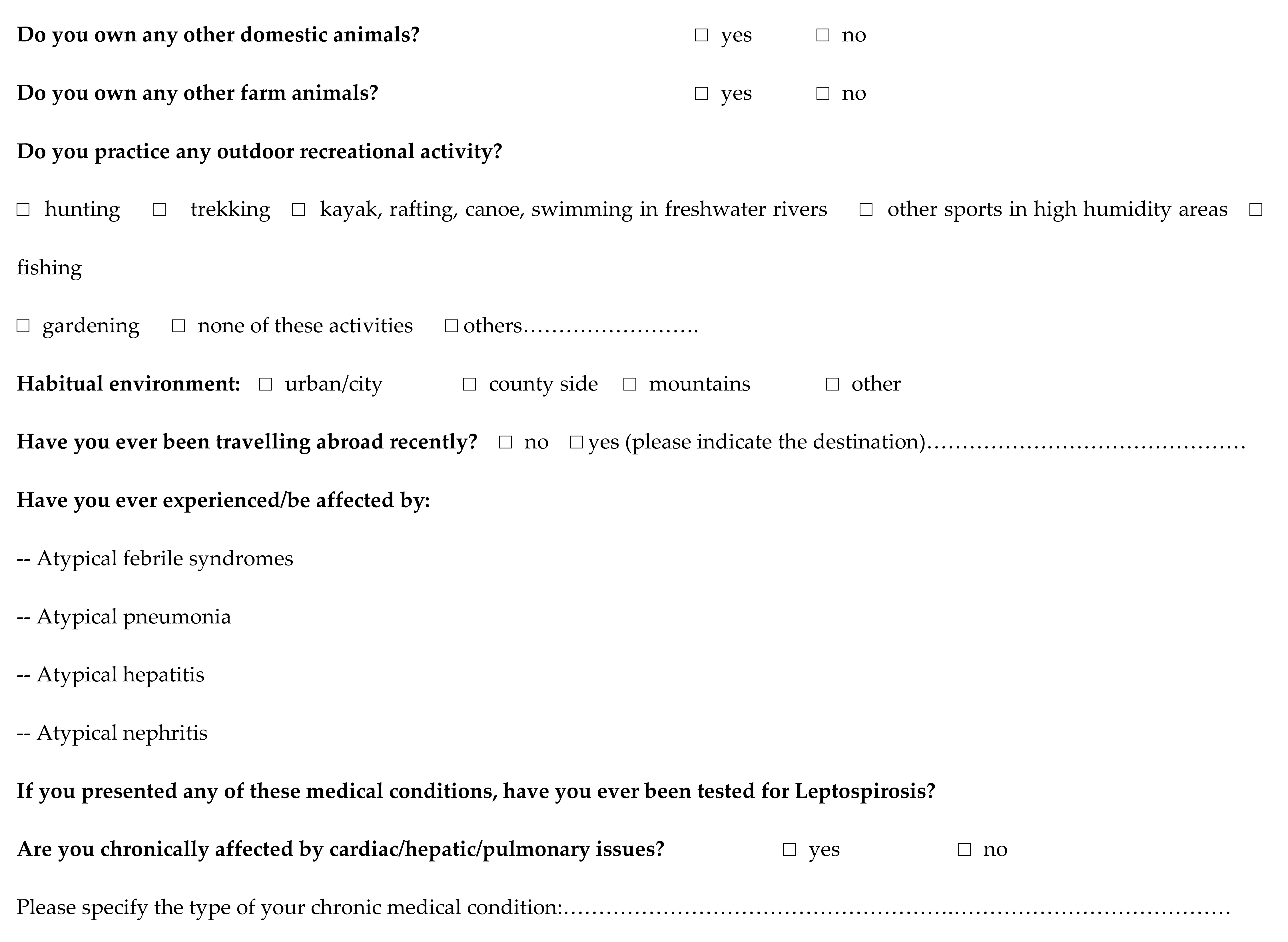Are Small Animal Practitioners Occupationally Exposed to Leptospirosis? Results of a Serological Survey
Abstract
:1. Introduction
2. Materials and Methods
2.1. Sample Population
- -
- N. 112 veterinarian small animal practitioners, as subjects exposed to professional risk due the contact with biological material potentially infected (blood, urine, …) and clinically ill dogs in a geographic area with high endemicity for canine leptospirosis (exposed population); no other health professionals or collaborators (e.g., zootechnical practitioners, shelter workers, kennel volunteers) were included in this category;
- -
- N. 109 people living in the same geographic area, not occupationally exposed to Leptospira infected animals (control population).
2.2. Serological Analysis
2.3. Statistical Analysis
3. Results
4. Discussion
5. Conclusions
Author Contributions
Funding
Institutional Review Board Statement
Informed Consent Statement
Data Availability Statement
Conflicts of Interest
Appendix A


References
- Haake, D.A.; Levett, P.N. Leptospirosis in humans. Curr. Top. Microbiol. Immunol. 2015, 387, 65–97. [Google Scholar] [CrossRef] [Green Version]
- Karpagam, K.B.; Ganesh, B. Leptospirosis: A neglected tropical zoonotic infection of public health importance—an updated review. Eur. J. Clin. Microbiol. Infect. Dis. 2020, 39, 835–846. [Google Scholar] [CrossRef]
- Bharti, A.R.; Nally, J.E.; Ricaldi, J.N.; Matthias, M.A.; Diaz, M.M.; Lovett, M.A.; Levett, P.N.; Gilman, R.H.; Willig, M.R.; Gotuzzo, E.; et al. Leptospirosis: A zoonotic disease of global importance. Lancet Infect. Dis. 2003, 3, 757–771. [Google Scholar] [CrossRef]
- Hotez, P.J.; Alvarado, M.; Basáñez, M.G.; Bolliger, I.; Bourne, R.; Boussinesq, M.; Brooker, S.J.; Brown, A.S.; Buckle, G.; Budke, C.M.; et al. The Global Burden of Disease Study 2010: Interpretation and Implications for the Neglected Tropical Diseases. PLoS Negl. Trop. Dis. 2014, 8, e2865. [Google Scholar] [CrossRef] [PubMed] [Green Version]
- Jittimanee, J.; Wongbutdee, J. Prevention and control of leptospirosis in people and surveillance of the pathogenic Leptospira in rats and in surface water found at villages. J. Infect. Public Health 2019, 12, 705–711. [Google Scholar] [CrossRef] [PubMed]
- Dupouey, J.; Faucher, B.; Edouard, S.; Richet, H.; Kodjo, A.; Drancourt, M.; Davoust, B. Human leptospirosis: An emerging risk in Europe? Comp. Immunol. Microbiol. Infect. Dis. 2014, 37, 77–83. [Google Scholar] [CrossRef] [PubMed]
- Vitale, M.; Agnello, S.; Chetta, M.; Amato, B.; Vitale, G.; Bella, C.D.; Vicari, D.; Presti, V.D. Human leptospirosis cases in Palermo Italy. The role of rodents and climate. J. Infect. Public Health 2018, 11, 209–214. [Google Scholar] [CrossRef] [PubMed]
- Ciceroni, L.; Stepan, E.; Pinto, A.; Pizzocaro, P.; Dettori, G.; Franzin, L.; Lupidi, R.; Mansueto, S.; Manera, A.; Ioli, A.; et al. Epidemiological trend of human leptospirosis in Italy between 1994 and 1996. Eur. J. Epidemiol. 2000, 16, 79–86. [Google Scholar] [CrossRef] [PubMed]
- Monno, R.; Fumarola, L.; Trerotoli, P.; Cavone, D.; Massaro, T.; Spinelli, L.; Rizzo, C.; Musti, M. Seroprevalence of Q-fever, brucellosis and leptospirosis in farmers and agricultural workers in Bari, southern Italy. Clin. Microbiol. Infect. 2009, 15 (Suppl. 2), 142–143. [Google Scholar] [CrossRef] [Green Version]
- Cacciapuoti, B.; Ciceroni, L.; Pinto, A.; Apollini, M.; Rondinella, V.; Bonomi, U.; Benedetti, E.; Cinco, M.; Dessì, S.; Dettori, G.; et al. Survey on the prevalence of leptospira infections in the Italian population. Eur. J. Epidemiol. 1994, 10, 173–180. [Google Scholar] [CrossRef]
- Cerri, D.; Ebani, V.V.; Fratini, F.; Pinzauti, P.; Andreani, E. Epidemiology of leptospirosis: Observations on serological data obtained by a “diagnostic laboratory for leptospirosis” from 1995 to 2001. New Microbiol. 2003, 26, 383–389. [Google Scholar]
- Bertasio, C.; Boniotti, M.B.; Lucchese, L.; Ceglie, L.; Bellinati, L.; Mazzucato, M.; Furlanello, T.; D’Incau, M.; Natale, A. Detection of New Leptospira Genotypes Infecting Symptomatic Dogs: Is a New Vaccine Formulation Needed? Pathogens 2020, 9, 484. [Google Scholar] [CrossRef] [PubMed]
- Pellizzer, P.; Todescato, A.; Benedetti, P.; Colussi, P.; Conz, P.; Cinco, M. Leptospirosis following a flood in the Veneto area, North-east Italy. Ann. Ig. 2006, 18, 453–456. [Google Scholar] [PubMed]
- Bonifica Brenta, C.; Veneto Finanziata Dalla R. Progetto Leptospirosi Atto Finale. 2004, pp. 1–67. Available online: https://www.consorziobrenta.it/pubblicazioni/ProgettoLeptospirosi.pdf (accessed on 31 December 2021).
- Lagi, F.; Corti, G.; Meli, M.; Pinto, A.; Bartoloni, A. Leptospirosis acquired by tourists in Venice, Italy. J. Travel. Med. 2013, 20, 128–130. [Google Scholar] [CrossRef] [PubMed]
- OIE (Office International des Epizooties). Leptospirosis. In Manual of Diagnostic Tests and Vaccines for Terrestrial Animals; Chapter 3.1.12; Office International des Epizooties: Paris, France, 2018; pp. 503–516. [Google Scholar]
- Barmettler, R.; Schweighauser, A.; Bigler, S.; Grooters, A.M.; Francey, T. Assessment of exposure to Leptospira serovars in veterinary staff and dog owners in contact with infected dogs. J. Am. Vet. Med. Assoc. 2011, 238, 183–188. [Google Scholar] [CrossRef] [Green Version]
- Rojas, P.; Monahan, A.M.; Schuller, S.; Miller, I.S.; Markey, B.K.; Nally, J.E. Detection and quantification of leptospires in urine of dogs: A maintenance host for the zoonotic disease leptospirosis. Eur. J. Clin. Microbiol. Infect. Dis. 2010, 29, 1305–1309. [Google Scholar] [CrossRef]
- Griebsch, C.; Kirkwood, N.; Ward, M.P.; So, W.; Weerakoon, L.; Donahoe, S.; Norris, J.M. Canine leptospirosis in Switzerland—A prospective cross-sectional study examining seroprevalence, risk factors and urinary shedding of pathogenic leptospires. Prev. Vet. Med. 2017, 141, 48–60. [Google Scholar] [CrossRef] [Green Version]
- Schreiber, P.; Martin, V.; Najbar, W.; Sanquer, A.; Gueguen, S.; Lebreux, B. Prevention of renal infection and urinary shedding in dogs by a Leptospira vaccination. Vet. Microbiol. 2005, 108, 113–118. [Google Scholar] [CrossRef]
- André-Fontaine, G. Canine leptospirosis—Do we have a problem? Vet Microbiol. 2006, 117, 19–24. [Google Scholar] [CrossRef]
- Wilson, S.; Stirling, C.; Thomas, A.; King, V.; Plevová, E.; Chromá, L.; Siedek, E.; Illambas, J.; Salt, J.; Sture, G. A new multivalent (DHPPi/L4R) canine combination vaccine prevents infection, shedding and clinical signs following experimental challenge with four Leptospira serovars. Vaccine 2013, 31, 3131–3134. [Google Scholar] [CrossRef]
- Miotto, B.A.; Guilloux, A.G.A.; Tozzi, B.F.; Moreno, L.Z.; da Hora, A.S.; Dias, R.A.; Heinemann, M.B.; Moreno, A.M.; Filho, A.F.D.S.; Lilenbaum, W.; et al. Prospective study of canine leptospirosis in shelter and stray dog populations: Identification of chronic carriers and different Leptospira species infecting dogs. PLoS ONE 2018, 13. [Google Scholar] [CrossRef] [PubMed] [Green Version]
- Piredda, I.; Ponti, M.N.; Piras, A.; Palmas, B.; Pintore, P.; Pedditzi, A.; Chisu, V. New Insights on Leptospira Infections in a Canine Population from North Sardinia, Italy: A Sero-Epidemiological Study. Biology 2021, 10, 507. [Google Scholar] [CrossRef] [PubMed]
- da Costa, R.S.; Di Azevedo, M.I.N.; Borges, A.L.D.S.B.; Carvalho-Costa, F.A.; Martins, G.; Lilenbaum, W. Persistent high leptospiral shedding by asymptomatic dogs in endemic areas triggers a serious public health concern. Animals 2021, 11, 937. [Google Scholar] [CrossRef] [PubMed]
- Hetrick, K.; Harkin, K.R.; Peddireddi, L.; Henningson, J. Evaluation by polymerase chain reaction assay of persistent shedding of pathogenic leptospires in the urine of dogs with leptospirosis. J. Vet. Intern. Med. 2022, 36, 133–140. [Google Scholar] [CrossRef] [PubMed]
| Risk Factor | Exposed N (%) | Unexposed N (%) | p-Value |
|---|---|---|---|
| Age (years) | 44.4 ± 9.8 | 39.6 ± 9.7 | <0.001 |
| Sex | |||
| F | 82 (73.2%) | 80 (73.4%) | NS |
| M | 30 (26.8%) | 29 (26.6%) | |
| Residence | |||
| Urban/town | 65 (58.0%) | 55 (50.1%) | NS |
| Village | 26 (23.2%) | 32 (29.6%) | |
| Rural | 16 (14.3%) | 20 (18.5%) | |
| Animal contacts | |||
| Pets | |||
| Frequent | 106 (94.6%) | 62 (56.9%) | <0.001 |
| Occasional | 6 (5.4%) | 18 (16.5%) | |
| No | 0 | 29 (26.6%) | |
| Farm animals | |||
| Frequent | 4 (3.6%) | 2 (1.8%) | NS |
| Occasional | 19 (16.9%) | 12 (11.0%) | |
| No | 89 (79.5%) | 95 (87.2%) | |
| Wild animals | |||
| Frequent | 2 (1.8%) | 1 (0.9%) | 0.025 |
| Occasional | 18 (16.1%) | 7 (6.4%) | |
| No | 92 (82.1%) | 101 (92.7%) | |
| Dog ownership | |||
| Yes | 67 (59.8%) | 41 (37.6%) | 0.001 |
| No | 45 (40.2%) | 68 (62.4%) | |
| Other animals ownership | |||
| Yes | 72 (64.3%) | 40 (37.6%) | <0.001 |
| No | 41 (35.7%) | 68 (62.4%) |
| Owned Dog Risk Factors | Exposed N (%) | Unexposed N (%) | p-Value |
|---|---|---|---|
| Usual inhabit | |||
| Indoor | 54 (80.6%) | 31 (75.6%) | NS |
| Indoor/outdoor | 8 (11.9%) | 4 (9.7%) | |
| Outdoor | 5 (7.5%) | 6 (14.6%) | |
| Wild/domestic animals contacts | |||
| Yes | 56 (83.6%) | 34 (82.9%) | NS |
| No | 11 (16.4%) | 7 (17.1%) | |
| Access to environmental freshwater sources | |||
| Frequent | 25 (37.3%) | 10 (24.4%) | NS |
| Occasional | 22 (32.8%) | 16 (39.0%) | |
| No | 20 (29.8%) | 15 (36.6%) | |
| Vaccination against Leptospira spp. | |||
| Yes | 56 (83.6%) | 29 (70.7%) | NS |
| No | 11 (16.4%) | 12 (29.3%) |
Publisher’s Note: MDPI stays neutral with regard to jurisdictional claims in published maps and institutional affiliations. |
© 2022 by the authors. Licensee MDPI, Basel, Switzerland. This article is an open access article distributed under the terms and conditions of the Creative Commons Attribution (CC BY) license (https://creativecommons.org/licenses/by/4.0/).
Share and Cite
Mazzotta, E.; Lucchese, L.; Salata, C.; Furlanello, T.; Baroni, E.; Zotti, A.; Venturi, G.; Fincato, A.; Marchione, S.; Capello, K.; et al. Are Small Animal Practitioners Occupationally Exposed to Leptospirosis? Results of a Serological Survey. Int. J. Environ. Res. Public Health 2022, 19, 1797. https://doi.org/10.3390/ijerph19031797
Mazzotta E, Lucchese L, Salata C, Furlanello T, Baroni E, Zotti A, Venturi G, Fincato A, Marchione S, Capello K, et al. Are Small Animal Practitioners Occupationally Exposed to Leptospirosis? Results of a Serological Survey. International Journal of Environmental Research and Public Health. 2022; 19(3):1797. https://doi.org/10.3390/ijerph19031797
Chicago/Turabian StyleMazzotta, Elisa, Laura Lucchese, Cristiano Salata, Tommaso Furlanello, Ermenegildo Baroni, Alessandro Zotti, Gabriele Venturi, Alice Fincato, Silvia Marchione, Katia Capello, and et al. 2022. "Are Small Animal Practitioners Occupationally Exposed to Leptospirosis? Results of a Serological Survey" International Journal of Environmental Research and Public Health 19, no. 3: 1797. https://doi.org/10.3390/ijerph19031797
APA StyleMazzotta, E., Lucchese, L., Salata, C., Furlanello, T., Baroni, E., Zotti, A., Venturi, G., Fincato, A., Marchione, S., Capello, K., & Natale, A. (2022). Are Small Animal Practitioners Occupationally Exposed to Leptospirosis? Results of a Serological Survey. International Journal of Environmental Research and Public Health, 19(3), 1797. https://doi.org/10.3390/ijerph19031797










